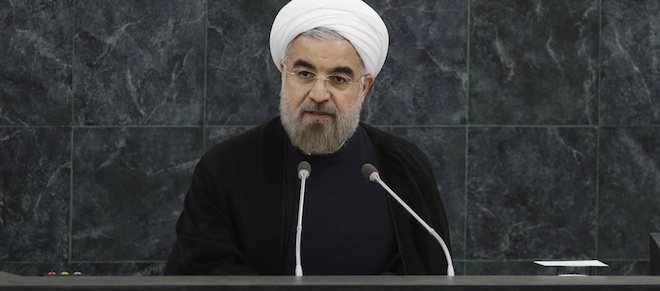When Obama (almost) met Rouhani
Iran and America consider a thaw
CORRECTS SPELLING OF FIRST NAME TO HASAN – Iranian President Hasan Rouhani addresses the 68th session of the United Nations General Assembly, Tuesday, Sept. 24, 2013 at U.N. headquarters. (AP Photo/Frank Franklin II)
Share

There is a telling anecdote in New Yorker writer Dexter Filkins’ remarkable profile of Quassem Suleimani, the head of Iran’s Revolutionary Guards’ Quds Force, an elite bunch of fighters and spies that tries to further Iranian foreign policy by every means available — from grunt-level soldiering to terror and assassinations.
In the weeks after the 9/11 terror attacks, senior State Department official Ryan Crocker frequently flew to Geneva to meet with a group of Iranian diplomats he understood were answering to Suleimani. Their common goal was defeating the Taliban, with whom Iran had nearly gone to war a few years earlier. (The Taliban brutally persecuted Afghanistan’s Shia minority, and Iran blamed them for the killing of Iranian diplomats in Mazar-i-Sharif).
At one point during these discussions, an Iranian showed Crocker a map indicating the locations of Taliban forces.
“Here’s our advice: hit them here first, and then hit them over here. And here’s the logic,” Crocker was told.
Shocked, Crocker asked if he could take notes.
The Iranian replied: “You can keep the map.”
The Americans reciprocated in one instance by revealing the location of an al-Qaeda agent living in Iran. He as arrested, turned over to Afghan authorities, and, Crocker believes, transferred to the Americans.
This cooperation unraveled when then president George W. Bush described Iran as a member of the “Axis of Evil.”
“We were that close,” Crocker lamented, referring to a new and more positive relationship between Iran and the United States. “One word in one speech changed history.”
IN SOME ways, this story seems to underline the potential for U.S.-Iranian reconciliation. Despite a long history of mutual hostility, the two countries have cooperated in the past based on a shared interests and may do so again.
The post-9/11 cooperation happened during the mandate of reformist president Mohammad Khatami.
Today, following the unwaveringly belligerent presidency of Mahmoud Ahmadinejad, Iran is again led by a reformist president, Hassan Rouhani, who in recent weeks has reached out to the West. His public relations efforts have included tweeting Jews a happy Rosh Hashanah and, this week at the United Nations, pledging Iran to “time-bound and result-oriented” talks on its nuclear program, which America believes is geared toward developing a bomb and Iran claims is peaceful.
There was much speculation that Obama and Rouhani might arrange to shake hands somewhere in the corridors of the United Nations. It didn’t happen, but Secretary of State John Kerry and his Iranian counterpart will meet Thursday — the highest-level meeting between the two countries since the 1979 Islamic Revolution.
It’s tempting to see all this as a second chance for greater harmony between Iran and the United States — rewinding to a time before the Axis of Evil, Iranian-trained militias killing Americans in Iraq, Bush and Ahmadinejad. Iran, it seems, wants to end its longstanding international isolation and the particularly intense animosity between it and America that has marked the last decade.
But when I think of Mohammad Khatami’s 1997 to 2005 presidency, it’s not the fledging cooperation with America on mutual security issues that comes to mind so much as the murderous 1999 crackdown on student protesters. The Khatami era, in other words, might have offered a window for better relations between Tehran and Washington, but it didn’t result in more freedom and less oppression for Iranian citizens.
Similarly, what’s striking about the speeches delivered at the United Nations this week by both Rouhani and U.S. President Barack Obama was the absence of any discussion on Iran’s ongoing human rights abuses. Obama didn’t mention the issue, so Rouhani didn’t have to.
To give credit where it is due, Rouhani did release some 80 political prisoners before his U.N. visit, including Canadian Hamid Ghassemi-Shall. But hundreds more remain. According to Amnesty International, almost 400 Iranians were executed this year alone. There is no sign that the oppression suffered by Iranian Baha’is will lessen under Rouhani. Progress between Iran and the West that’s solely focused on the nuclear file won’t change this.
Even on nukes, it’s unclear that Rouhani can deliver. He claims he has the authority to strike a deal. But the presidency is not the only pillar of power in Iran. The country’s supreme leader, Ayatollah Ali Khamenei, will have a veto. The Revolutionary Guards cannot be ignored.
None of this means Rouhani’s overtures should be dismissed. Although he comes from the Islamic Republic’s establishment, he was brought to power by millions of Iranian voters who genuinely want their country to change, and to change its relationship with the rest of the world. For better or worse, he is their most powerful voice right now. He may yet use it to good effect, but healthy skepticism is warranted.